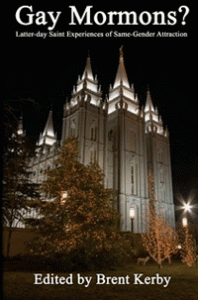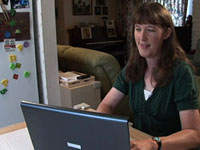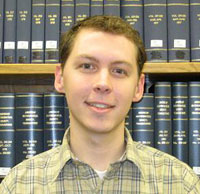“Gay Mormons?” A Review
“Even without an epilogue or summary, the book is an important one and will provide insight and support to anyone who wants to know what it’s like to be gay and Mormon”
by Laura Compton
October 2011
Laura Compton is a blogger with Mormons for Marriage. Originally posted on the Mormons for Marriage website. Reposted with permission.
Yes, there are gay Mormons, and their stories are compelling. Brent Kerby’s put a bunch of them into one book, now available online and in paperback or on Kindles.
As more people in American society find safety in sharing with friends and family that they are attracted to members of the same sex, it’s no surprise that Mormons are coming out in increasing numbers as well. And, just as members of the GLBT community and their straight allies have been telling their life stories, gay Mormons are telling their stories as well, this
time in a book and e-book compiled by Brent Kerby, a gay Mormon himself.
Gay Mormons? Latter-day Saint Experiences of Same-Gender Attraction follows the pattern set forth in Carol Lynn Pearson’s groundbreaking work, No More Good-byes: Circling the Wagons Around Our Gay Loved Ones. But while many of the subjects in Pearson’s collection struggled with rejection, depression and suicide, nearly every essay in Gay Mormons ends on a hopeful or encouraging note, kind of like a written Mormon version of It Gets Better.
But despite the hope, there are still too many stories with tears, pain, isolation and depression. Thankfully, many of the essayists in Gay Mormons have benefited from Pearson’s (and others’) insistence that Mormons need to show more appreciation, love, understanding and patience for those “out on the plains” seeking comfort, hope and shelter.
Unsurprisingly, nearly all of the stories follow the same pattern of early recognition of  differences in attraction, coming to terms with oneself and one’s family, and then deciding what to do from there, whether the decision leads to change or stay the same; to remain in the church or not; or to marry a straight spouse or find a same-sex partner or remain single:
differences in attraction, coming to terms with oneself and one’s family, and then deciding what to do from there, whether the decision leads to change or stay the same; to remain in the church or not; or to marry a straight spouse or find a same-sex partner or remain single:
“Over the past year I have come to realize that there is strength in numbers – at church, in support groups, and social circles. It definitely helps to have other people alongside you who are facing what you’re facing.” (129)
“Growing up I always felt a bit different….When I was about seven or eight, something interesting happened. One of my friends got a girlfriend!…I found it weird that a boy would like a girl. It just didn’t make sense to me” (56-7)
“I couldn’t understand why I wasn’t able to make a friend who cared about me the same way I cared about him. I assumed it must be because I wasn’t likeable enough.” (21)
“I read the entire article [Helping Those Who Struggle With Same-Gender Attraction], being careful to make sure nobody saw me reading it. Then I put it aside, thinking it didn’t really apply to me. And yet, deep down I sensed it had at least some relevance.” (20)
“I was starting to become conscious of the fact that I might be attracted to guys. That said, I had convinced myself that there was no way I could be gay. In my mind, gays were people who liked cross-dressing, promiscuous sex, drugs, and alcohol – all things that I wanted no part of.” (270)
“There were a lot of sleepless nights on that cruise. I tossed and turned, worried, wrestled with my thoughts, prayed for forgiveness and a miracle. ‘Please God, don’t let me be gay … but what if I’m gay?’ Over and over and over.” (201)
“Over the years, shame has caused me to flounder in isolation” (330)
“Finally, just before I turned 18, a thought occurred to me that I should kneel down and ask Heavenly Father himself if being gay was so wrong. I had always been taught these things, but I had never actually asked for myself. I have to tell you, the overwhelming feeling of comfort I received was more powerful than anything I can possibly describe….I wept with joy that I wasn’t evil after all. I wept in grief for all the wasted years spent hating myself. I wept at the confirmation that not only was being gay okay, it was part of God’s plan for me…I had finally come to terms with my sexuality and fully embraced the fact that I am gay. I was finally ready to come out to the world and live honestly. I was sick of the shame I felt in hiding all these years.” (92-3)
“Once I was open and honest about who I truly was and why I had been so incredibly depressed, I became a new man….The light was back behind my eyes and the gleam in my smile was dazzling once again.” (95)
“I was at a crossroads. I wanted to keep going to church, but I wanted to accept myself. It was probably the most conflicting and trying time for me. It was when I contemplated suicide the most.” (149)
“Those who felt powerless to change their feelings were called ‘weaklings.’ I placed all my trust in my Church leaders. Hearing myself described in such language, I could not help but feel unworthy of God’s love. I created a wall within myself. On the one side I was what everyone expected me to be. I fulfilled my callings the best I could. I attended church faithfully. I did what I could to make sure that no one would ever know how wrong I felt. On the other side I would steal glances here and there at cute guys, and I would flip through my mom’s clothing catalog to see the handsome guys and dream.” (70)
“For me, there was a lot of shame in my attractions. I felt that in order to have self-esteem I would need to be straight. Yet here I saw all these [gay] people who were fine with themselves and were living the gospel. It really helped me look at things in a different light.” (177)
“The more I [tried to change], the more I realized it wasn’t working. I decided not to go [to counseling] any more. The visits with the counselor were only making me feel more anxious and lonely. I felt like I had been lied to. It was very disillusioning when I had done everything I was supposed to do, and yet my feelings for guys had only grown stronger.” (296)
“I had hoped my mission would set me on track and that I would be able to get married soon afterwards. This was not the case, and as I faced my emotions, I began to feel that I was not meant to remain within the Church, but I decided I still had to strive to overcome and remain faithful to my covenants….I am happy now. There are very few things now that I wish to change….I love my partner and want my family to understand that I am happy – even without being active in the Mormon faith. I love my family and want them to understand that they know and love someone gay.” (170)
“I believe that he loves me just the way I am. I prayed for a long time for Him to take these feelings away from me, and He didn’t. So what that tells me is that it doesn’t matter to Him if I’m gay. It’s not that big of a deal to Him.” (86)
“One Sunday as we stood sharing a hymnbook, I glanced at her had next to mine and realized that I had fallen in love. It was a sign that perhaps the cure had come. Admittedly, I still checked out nearly every man I saw despite my best efforts to the contrary, but the fact that I was in love with a woman stood as a witness that my desires might actually change.” (252)
“One time when I was in the temple, I had a revelation that one of my talents is being gay, and that I should devote that to the Church. I hope that my being open and active in the Church may help it be a safer place for our youth to be open. I want people to know that it is possible for someone to be gay and maintain Church standards and not hide….the thing is, it’s not really about me. It’s about these teenagers who are coming out to their families and bishops right now, who really need support.” (212)
“Being gay does not mean that I live or support the ‘gay lifestyle’. That is to say I am still the same clean, honest, and good person that you have known and been proud of for all these years.” (274)
“I decided to ask [my LDS counselor] a question that had been in my mind for quite a while: ‘What is love?’ Silence ensued. He looked me straight in the eye. ‘That’s an interesting question,’ he answered calmly…Then my real question burst out, ‘Can gay people feel true love for each other, or are their feelings simply something evil, twisted and unnatural?’ He scratched his head, moved closer to me and then said something that I will always remember: True love is a feeling of connection with another person. These feelings are not only physical but also emotional and spiritual. Since God has forbidden these kinds of relationships, that implies that it’s not possible for a gay couple to connect spiritually, and therefore they cannot feel real, true love….[then] I met ‘James’….But what surprised me the most was that I could connect with him not only emotionally but also spiritually. We had deep conversations about many topics….How could something that had been so poignantly described as evil, perverse, and wrong produce such feelings of comfort, joy and contentment?” (61-2)
“Gay people long for love just like straight people do. Up until the point that I read these books, I would think things like, ‘Why would gay people want to get married? Why don’t they just sleep with whomever they want?’ because I didn’t understand that there’s still that desire to have a committed relationship.” (126)
“What if, instead of speaking about homosexuality as abomination and perversion, my leaders had acknowledged as the Church does today that, ‘Same-gender attractions include deep emotional, social and physical feelings. All of Heavenly Father’s children desire to love and be loved’? Instead of taking my temple recommend away and denying me a calling and the sacrament, what if my bishop had taken the time to get to know me better as a person, to let me know that I was loved and valued? Why was it that an Episcopal priest who knew nothing about me seemed more sensitive to my anguish than my own priesthood leaders?” (107)
“In our generation, young LDS people are so loving and open; it is literally changing the world. It seems like they are really taking the doctrine to heart, treating everyone equal, like we’re all children of God. But I just don’t know what it would be like at church.” (164)
“If you’re someone who’s struggling to deal with this, know that you’re not the only one. That is the one thing I wish I had known growing up; I felt like I was the only gay Mormon. But there is an entire world out there.” (156)
Most of the contributors to Gay Mormons are young, and many have just come out within the past decade, a surprising number as recently as 2008. Kerby’s brief introduction provides some context about the current state of affairs between the LDS Church and its GLBT members and former members. A glossary of terms helps cut through some of the Mormon jargon and a list of resources provides information and internet links for dozens of sites dealing with all aspects of GLBT experiences. Most of the resources are referred to by one or more essayists, which explains the inclusion of what some would otherwise questionable links.
The only thing that’s missing is a final chapter or two summing up where we are and where might we go from here. But even without an epilogue or summary, the book is an important one and will provide insight and support to anyone who wants to know what it’s like to be gay and Mormon.

